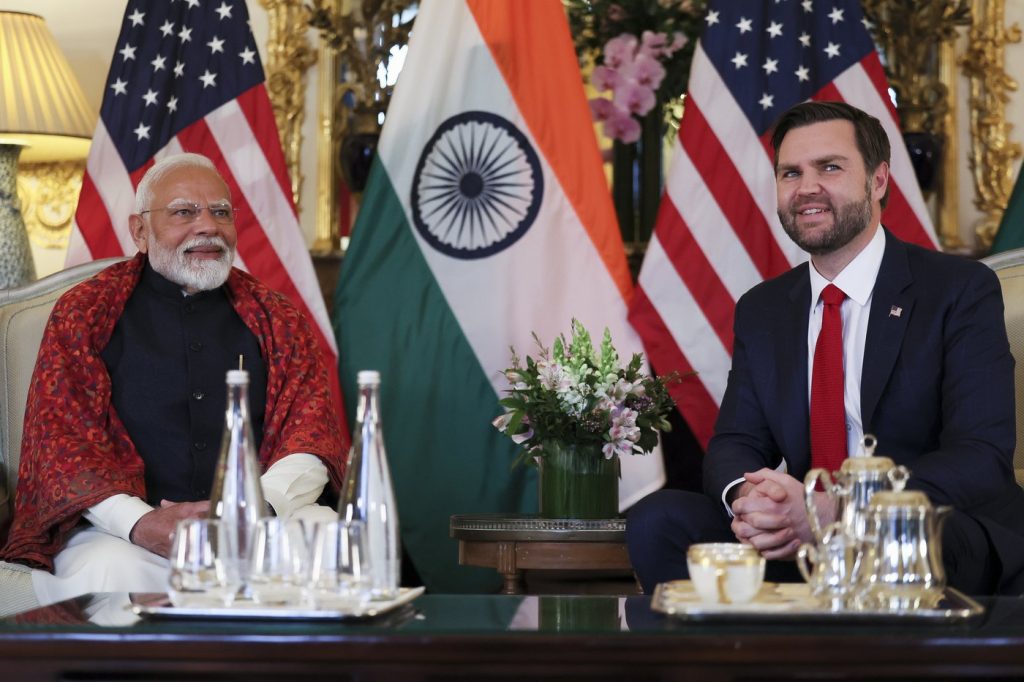U.S. Vice President JD Vance is set to commence a four-day visit to India starting from Monday, as both countries aim to strengthen their economic ties and negotiate a bilateral trade agreement. This visit is of particular significance as it occurs amidst a trade war between the United States and China, New Delhi's main rival in the region. Vance will engage in discussions with Indian Prime Minister Narendra Modi in New Delhi, focusing on economic, trade, and geopolitical matters.
Both leaders are viewing this visit as an opportunity to review the advancement of bilateral relations. The United States is currently India’s largest trading partner, with bilateral trade valued at approximately $190 billion. The two nations are targeting to enhance this relationship by aiming to double their trade to $500 billion by the year 2030 under the anticipated trade deal.
Vance’s arrival comes shortly after Director of National Intelligence Tulsi Gabbard participated in a geopolitical conference in India and only two months after Modi's visit to Washington, where he and President Donald Trump initiated negotiations to mitigate potential repercussions from Trump’s tariffs. Despite these efforts, India has faced tariffs imposed by Trump as part of his original trade policy, which included a 26% levy, although this program has been temporarily paused.
During his prior visit to Washington, Modi emphasized strengthening trade ties, suggesting he is open to further reducing tariffs on U.S. goods and increasing purchases related to military equipment. The agreements established during his meeting with Trump were aimed at addressing trade barriers and fostering new avenues for collaboration.
India’s relationship with the United States is expansive, encompassing trade, foreign direct investments, defense cooperation, and strategic alliances aimed at countering rising Chinese influence in the Indo-Pacific region. India is also a key member of the Quadrilateral Security Dialogue (Quad), which includes the U.S., Japan, and Australia.
Numerous American companies, such as Apple and Google, have significantly expanded operations in India, indicating a growing interdependence between the two economies. Recently, Musk’s Starlink has entered into agreements with major telecom providers in India to offer satellite-based internet services, further deepening commercial ties.
However, the urgency of trade negotiations is underscored by the risk posed to Indian sectors, particularly agriculture and manufactured goods, due to Trump's possible reciprocal tariffs. Such tariffs could impact Modi's administration's goal of economic recovery through export-led growth and job creation.
Modi and Trump have previously fostered a positive working relationship that may become increasingly important as both leaders seek to enhance cooperation amidst ongoing geopolitical challenges posed by China. India has made overtures to Trump by pledging to procure more oil and defense equipment from the U.S., including advanced military aircraft.
Despite these advancements, the U.S. seeks increased access for its agricultural exports in India, a sensitive topic given that the agricultural sector employs a large portion of the Indian workforce. The nuanced dynamics of these trade discussions highlight the complexities inherent in global commerce.
Significantly, this marks JD Vance's first official trip to India, which holds personal meaning as his wife, Usha Vance, is a practicing Hindu and the daughter of South Indian immigrants. Usha's family immigrated to the U.S. in the late 1970s, and Vance has credited her as a key influence in his life, acknowledging her insights in his memoir, "Hillbilly Elegy."
Accompanied by his family and senior U.S. officials, Vance plans to explore cultural sites in Indian cities like Jaipur and Agra. This visit not only marks a pivotal moment in U.S.-India relations but also offers a glimpse into the personal connections that often shape diplomatic engagements.










